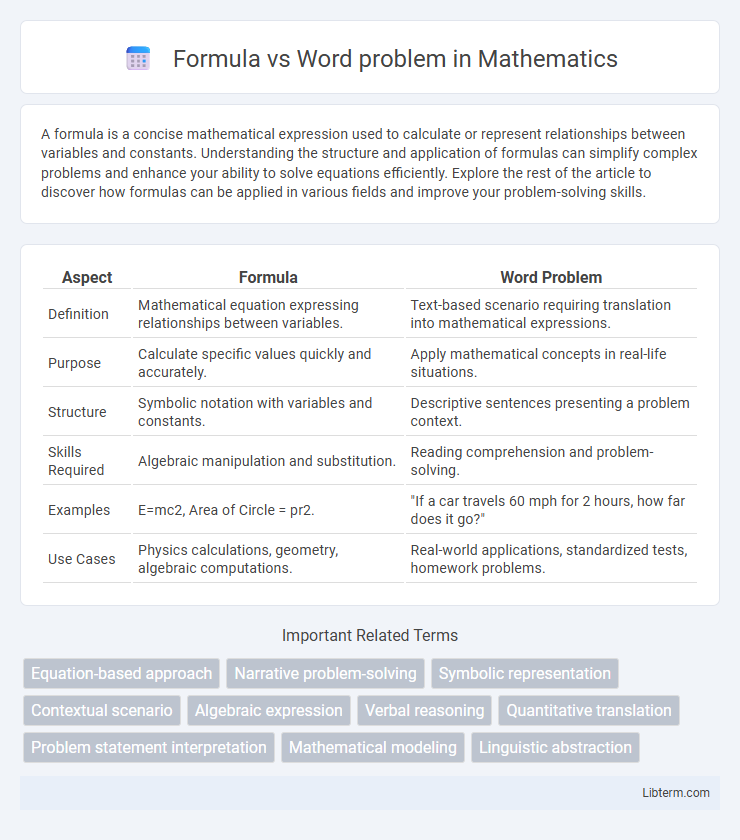A formula is a concise mathematical expression used to calculate or represent relationships between variables and constants. Understanding the structure and application of formulas can simplify complex problems and enhance your ability to solve equations efficiently. Explore the rest of the article to discover how formulas can be applied in various fields and improve your problem-solving skills.
Table of Comparison
| Aspect | Formula | Word Problem |
|---|---|---|
| Definition | Mathematical equation expressing relationships between variables. | Text-based scenario requiring translation into mathematical expressions. |
| Purpose | Calculate specific values quickly and accurately. | Apply mathematical concepts in real-life situations. |
| Structure | Symbolic notation with variables and constants. | Descriptive sentences presenting a problem context. |
| Skills Required | Algebraic manipulation and substitution. | Reading comprehension and problem-solving. |
| Examples | E=mc2, Area of Circle = pr2. | "If a car travels 60 mph for 2 hours, how far does it go?" |
| Use Cases | Physics calculations, geometry, algebraic computations. | Real-world applications, standardized tests, homework problems. |
Understanding the Difference: Formula vs Word Problem
Formula problems require applying a specific mathematical equation to calculate an exact value, emphasizing symbolic manipulation and procedural accuracy. Word problems involve interpreting a real-life scenario described in text, extracting relevant information, and translating it into a mathematical expression or equation to solve. Understanding the difference between formula and word problems enhances problem-solving skills by enabling clear identification of when to use direct computation versus analytical reasoning from contextual information.
Defining Formulas in Math Problems
Defining formulas in math problems involves translating word problems into mathematical expressions to represent relationships between variables clearly. Formulas serve as a bridge, converting descriptive language into quantifiable terms that can be manipulated algebraically. Effective formula definition enhances problem-solving accuracy by providing a structured method to calculate unknown values systematically.
What Are Word Problems?
Word problems are mathematical questions presented in a narrative format, requiring translation of real-life scenarios into equations or formulas. They emphasize comprehension and application of concepts such as addition, subtraction, multiplication, or division within practical contexts. Understanding key terms and recognizing relevant data are essential for accurately solving these problems.
Key Characteristics of Formulas
Formulas represent mathematical relationships using symbols and structured expressions, enabling precise calculations and systematic problem-solving. They provide a concise method to encode variables and constants, facilitating quick substitution and manipulation for diverse scenarios. The key characteristics of formulas include clarity, universality, and reproducibility, which make them essential tools in fields like physics, engineering, and finance.
Essential Elements of Word Problems
Essential elements of word problems include clear identification of unknowns, relevant data, and the relationships between quantities, which guide the formulation of the correct equation. Understanding the context and translating the problem's narrative into mathematical expressions are crucial for solving word problems effectively. Formula problems, by contrast, present direct application of known equations, whereas word problems require interpretation and problem modeling based on given information.
When to Use Formulas vs Word Problems
Formulas are ideal for solving problems with clearly defined variables and mathematical relationships, enabling efficient calculation and precise results. Word problems are best suited for real-world scenarios requiring interpretation of context and translation into mathematical expressions. Use formulas when the problem is straightforward and numerical, and opt for word problems when analyzing complex situations that demand critical thinking and reasoning.
Benefits and Challenges of Using Formulas
Formulas provide a precise and efficient method for solving math problems, enabling quick calculations and consistent results. They simplify complex problems by breaking them down into standardized expressions, which enhances accuracy and reduces cognitive load. Challenges include potential misapplication due to misunderstanding formula conditions and the risk of overlooking conceptual understanding when relying solely on formulas.
Advantages and Difficulties of Solving Word Problems
Word problems enhance critical thinking by applying formulas to real-life scenarios, improving comprehension and problem-solving skills through context-based learning. They often present difficulties such as ambiguous language, requiring careful interpretation and translation into mathematical expressions. Success in solving word problems depends on mastery of language and mathematical concepts, bridging abstract formulas with practical applications.
Common Mistakes in Interpreting Formulas and Word Problems
Misinterpreting variables and constants in formulas often leads to incorrect problem-solving, as students may confuse what each symbol represents. In word problems, overlooking key quantitative details or misreading relationships between quantities can result in flawed equation setup and inaccurate conclusions. Common errors include substituting values improperly, ignoring units, and failing to translate verbal descriptions into correct mathematical expressions.
Tips for Transitioning Between Formulas and Word Problems
Mastering the transition between formulas and word problems involves identifying key terms that signal specific mathematical operations, such as "sum" indicating addition or "product" for multiplication. Translating the problem's context into variables and equations helps clarify relationships and simplify complex scenarios into solvable formulas. Practicing with diverse problem types strengthens the ability to recognize patterns and apply appropriate formulas efficiently.
Formula Infographic

 libterm.com
libterm.com